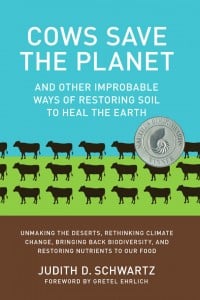
Cows Save The Planet

Contributor
 Bovine superhero of planetary rescue? A seemingly unlikely scenario; indeed cows get blamed for a good many offenses. But this catchy 2013 title from journalist Judith D. Schwartz certainly got my attention. And our attention is what’s really at stake, isn’t it? Like an insidious form of contemporary climate kryptonite, despair and hopelessness about the state of our fragile blue and green planet breed more of the same. A far cry from the empowering optimism described by Gretel Ehrlich in the foreword to this book: “Judith Schwartz’s book gives us not just hope but also a sense that we humans—serial destroyers that we are—can actually turn the climate crisis around.”
Bovine superhero of planetary rescue? A seemingly unlikely scenario; indeed cows get blamed for a good many offenses. But this catchy 2013 title from journalist Judith D. Schwartz certainly got my attention. And our attention is what’s really at stake, isn’t it? Like an insidious form of contemporary climate kryptonite, despair and hopelessness about the state of our fragile blue and green planet breed more of the same. A far cry from the empowering optimism described by Gretel Ehrlich in the foreword to this book: “Judith Schwartz’s book gives us not just hope but also a sense that we humans—serial destroyers that we are—can actually turn the climate crisis around.”
Dirt: a substance to be wiped from our feet, scrubbed from our food, and plowed in fields, or, as Schwartz so poetically describes it, the “imperceptible, animal-vegetable-mineral dance that keeps us alive”? The very premise of this enjoyable read, on an admittedly dense subject, is if we attend to the soil, the world’s ecological cycles will begin to correct themselves.
In a refreshing departure from doom and gloom Schwartz offers hope and actionable tools, backed up by sound science. Accelerated topsoil formation is doable. Demonstrated by land restoration projects based on managed herds of ugulates (i.e., cows and other grazing animals), and zia pits, a growing method developed in West Africa to capture and hold water and organic matter in a dry climate, and assisted by a diversity of worms, insects, and microorganisms like bacteria and fungi. Think of the impact of being freed from the constraints of geological time?
Healthy, living soil acts as a natural sponge to counter the effects of both drought and deluge, to say nothing of providing nutrient-dense food that actually feeds us when we eat. Consider how that might impact the obesity epidemic, chronic health problems, and rising medical costs. And soil is a natural and cost effective solution to rising carbon emissions. Remove carbon from the air where it mixes with oxygen to form toxic carbon dioxide gas and put it back in the ground where it boosts soil fertility.
People featured in this book are creative thought leaders looking to make a difference in the face of a big topic; some would say the defining issue of our time. With accessible language, optimism, and humor—I mean really, cows save the planet—Schwartz has written a call to action on behalf of the soil. Her message is for anyone and everyone who tends the land. As a gardener, I can be a part of the solution. What a wonderful thought.
Lorene Edwards Forkner, editor










Responses